Off the coast of Maine, puffins are rebounding and feasting on a new snack
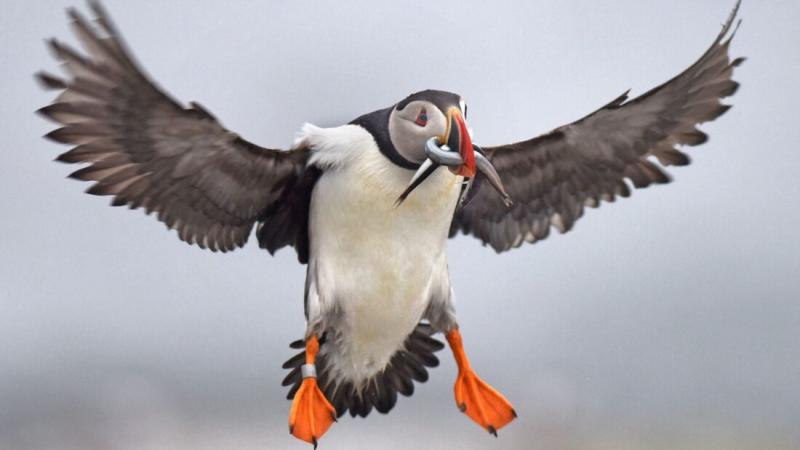
The 50th anniversary of Project Puffin has just ended, with researchers fully realizing how their quest has morphed from saving one bird to playing a part in saving the planet.
Its purpose in 1973 was simply to return puffins to islands off the coast of Maine, where hunters had killed them off by the late 1800s. Led by Steve Kress, then an Audubon camp bird instructor in his late 20s, the project moved puffin chicks here from Newfoundland.
The effort became the world’s first successful seabird restoration of its kind. There are now more than 1,300 breeding pairs of puffins across several Maine islands. The irony is that a bird that gives us a sense of the watery riches of Maine in the 19th century today warns us how we are impoverishing our oceans.
The warning zoomed past me while I sat in bird blinds.
It was early July on Eastern Egg Rock, a seven-acre island six miles off Pemaquid Point and the original site of the project. Puffins began breeding anew here in 1981, and the population reached a record high of 188 breeding pairs in 2019.
Early July is the time of summer when scores of puffin chicks hatch in burrows under the boulders of the island, triggering one of nature’s most amazing sights. At dawn, parents pop out of the dark of burrow openings one by one, surveying their surroundings in the yawning manner of humans rubbing their eyes as they rise from bed. They then take off and fly out of sight over the Gulf of Maine.
About 45 minutes later, an aerial parade of parents return with glistening, silver beak loads of fish in their mouths. Some zip over the boulders from the right, others from the left. Some come straight at me to burrow directly in front of my blind. Some arrivals are so simultaneous, I can’t keep track. They all plunge back into burrows with breakfast for chicks.
The parade was among the most memorable in the project’s history because of the species of fish that nearly every puffin parent and many terns brought back:
Sand lance.
Small in size and obscure in direct value to humans, you will not see this fish on ice at the seafood counter. But many of the fish we prize in the pan or sizzle on the grill are there because of sand lance.
They are eel-like, which makes them as easy to swallow as spaghetti, 4 to 8 inches long as adults, and high in fats. That makes sand lance royalty in the realm of “forage fish,” a banquet for much larger creatures.
According to a 2020 study by two dozen government, university and marine institute scientists, 72 animal species eat sand lance in Atlantic waters from North Carolina to Greenland.
The fish include cod, bluefin tuna, haddock, flounder, striped bass, herring and bluefish. The mammals include whales and seals, and the seabirds include gannets, endangered roseate terns and yes, puffins.
Sand lance is not normally the top food for puffins in the Gulf of Maine; it historically is a supplement to other cold-water fish. In the early decades of Project Puffin, hake and herring were the top choices.
Hake became the dominant fish as herring declined from multiple impacts. Herring is also overfished, and a major 2021 study said its decline is also consistent with climate disruptions in the marine food web.
In more recent years, haddock has sometimes been a major supplement, as species rebounded with federal and state management. Citing 2017 data, the Massachusetts Division of Marine Fisheries website says, “haddock are currently experiencing a record abundance in the Gulf of Maine and on Georges Bank.”
(But in yet another example of how humans so quickly alter the oceans, a 2022 federal stock assessment says there is new evidence that haddock in the Gulf of Maine are suffering from a new round of overfishing).
Add in the altered weather patterns brought by human-made climate change and puffins no longer know from year to year what they can find.
The Gulf of Maine is one of the fastest-warming swaths of ocean in the world, with frequent marine heat waves that drive cold-water species too deep or too far out to sea for puffins to catch. Often taking their place are more southerly fish too oval for small chicks to eat, such as butterfish.
But just when you think this chaos is all bad news for the seabirds, the new mélange of ocean conditions for the second straight year delivered jaw-dropping feasts to puffins.
Last year, puffin parents flew onto the islands with unprecedented levels of elongated Atlantic saury, dramatically dangling a half foot or more from their beaks to feed chicks.
No one knows why this forage fish appeared. Saury are highly mobile, with little data connecting its movements to climate change.
This year it was sand lance. The only other year over the last quarter-century that sand lance was so abundant was 2015. It is not clear why because not only is it a cold-water species, but its presence is highly tied to what it eats, the zooplankton Calanus finmarchicus, which itself is projected to dramatically decline with warming waters. But in that blind on Eastern Egg Rock, in early July, I observed 61 feedings in a morning, 60 of them sand lance.
There were similar sights elsewhere in the Gulf of Maine. On Seal Island, 32 miles to the east, one researcher wrote in the island journal, “I tried to keep up with the astonishing number of puffins circling the blind, bills heavy with sand lance. I got more feedings than I ever have before, and about twice as many as in a normal stint!”
Then, in mid-July, as if a switch flipped in the ocean, the sand lance disappeared. For the most part, the puffins did not miss a beat. On some islands, puffins swapped it out for mostly haddock. On others, parents switched to more of a smorgasbord of haddock, hake and redfish.
By July 22, when I stayed on Seal Island, the feedings were vastly of haddock, with some hake. This also amazed Don Lyons, director of conservation science for Project Puffin, formerly known as National Audubon’s Seabird Institute.
“I can’t offhand recall such a seamless transition from one fish to another,” Lyons said. “It tells you a lot about the resourcefulness of puffins and at the same time, it’s a reminder of how much we still don’t know of when and where food is for seabirds, and how fast that all can change.”
For Tracey Faber, the supervisor of Matinicus Rock and a longtime Project Puffin research assistant, both the sand lance and sudden shift to haddock was cause for nuanced celebration. She said while it was important that haddock helped puffins fledge chicks through later July, haddock also are significantly less fatty than sand lance, hake or herring, providing less nutrition.
She said she worries about puffins hitting a threshold, because of climate change, of being able to change their foraging habits from “boom and bust” fish such as saury and sand lance to other species.
Arctic terns, for instance, had much more trouble finding food on Matinicus Rock and Seal Island when the sand lance disappeared, sadly settling for tiny crustaceans.
On Seal Island, the crew, supervised by Faber’s sister Coco, noted how several terns that fledged with some of the highest weights recorded in recent years, came back to plots to die.
“Without consistently available species that can be provisioned throughout the entire chick-rearing process, productivity in any given year will be far more dependent on these unpredictable fish species,” Tracey Faber said.
That makes you wonder what the summer would have been like without sand lance at all, because it was otherwise difficult for seabirds in the Gulf of Maine. Two years ago, record water warmth and record rain resulted in catastrophic nesting failure. Last year, with calmer weather, seabirds rebounded beautifully.
This year was marked with more above-average heavy rains and more continuous days of soaking fog than veteran researchers could remember. Tern nests were flooded to the point where eggs floated in them, and a significant number of hatched chicks soaked to death.
Puffins on Seal Island and Matinicus Rock were hit hard. Seal Island had the lowest puffin egg hatching rates in five years and chick survival rates just above the disastrous levels of 2021. Matinicus Rock had the lowest puffin hatch success in a decade. Petit Manan also lost puffin nests due to storms.
For puffins that did hatch, many chicks grew to nice weights on some islands, fortified by the sand lance. On Petit Manan, the early banquet of sand lance might have given chicks critical sustenance; two heat waves in July drove away supplemental prey to the extent that the chicks rapidly dropped weight. Cooler waters mercifully returned, and the chicks started gaining weight again.
Tasha Gownaris, a Gettysburg College environmental studies professor whose lab conducts research on Petit Manan, said the heat waves “likely exceeded the thermal tolerance limit of herring and hake. Scary stuff.”
The fog and rain also sometimes made it impossible for researchers to locate and deal with predators. Several islands were plagued with mink, owls, peregrine falcons or black crowned night herons that tore through tern colonies. On Eastern Egg Rock, some voracious gulls used the fog as cover to prey on tern chicks.
Matinicus Rock had to contend with clever ravens that last year killed nearly 50 puffins, and a ruddy turnstone that this summer wiped out at least 50 Arctic and common tern nests. Petit Manan saw a significant amount of tern nest abandonment, probably because a peregrine falcon took advantage of the fog to terrorize the colonies.
“Even when you knew a predator was out there, the fog made it so you couldn’t even leave the cabin,” said Meg Getzinger, an Eastern Egg Rock research assistant. “It was sometimes so wet, you didn’t want to walk out there and kick up the tern colony, because the parents were working so hard to cover up their chicks. If we stirred them up, that would expose the chicks to yet more water.”
This summer also brought more sobering evidence of what the whole world is exposing seabirds to, when the whole world is their ecosystem. Keenan Yakola, a 10-year veteran of Project Puffin and a doctoral student at Oregon State, noted how many Arctic terns arrived to Gulf of Maine islands with poor weight; possibly their winter food supply in the Antarctic was disrupted by the same record low levels of sea ice that is causing total nesting failures for emperor penguins.
On Petit Manan, Gownaris and Linda Welch, biologist for the Maine Coastal Islands National Wildlife Refuge, also noted how Arctic terns arrived this spring lighter in weight.
Yakola and partners such as Welch are making other connections with modern technology to remind people of the vital importance of waters far from where Maine’s summer tourists might see a puffin.
For instance, GPS tagging on Matinicus Rock of another species, Leach’s storm petrels, have shown for two straight years that the bird flies down to the latitude of Philadelphia to forage for chicks in the Northeast Canyons and Seamounts National Marine Monument. Puffins also feed in the monument during the winter.
Other joint tracking projects between the Maine Coastal Islands refuge and Project Puffin have detailed the incredible migration of Arctic terns. Some Gulf of Maine terns wind all the way around South Africa into the Indian Ocean before wintering along the Antarctic ice pack.
“There are so many greater connections that we don’t pay attention to,” said Yakola, who hopes that research leads to a broader public concept of what an “ecosystem” is, and informs efforts in other nations to protect migrating birds wherever they are vulnerable. “It’s important to keep talking about how the Gulf of Maine is heating up,” Yakola said. “But the birds leave the Gulf for seven or eight months, most of the year. We must keep making connections.”
Tens of thousands of seabirds did successfully fledge chicks in the Gulf of Maine this summer. Overall bird populations on many islands remained strong. In mid-August, at the season-ending conference of the Gulf of Maine Seabird Working Group, several islands in the Cape Cod region reported increases in various tern populations.
The White and Seavey Islands off New Hampshire reported a record number of nests for the federally endangered roseate tern. Pond Island had a record number of common tern nests. Among islands managed by the Maine Coastal Islands refuge, terns on Metinic and Ship did well while making a successful transition from sand lance to herring or hake.
The longevity of seabirds also cheered researchers. On Eastern Egg Rock, the crew welcomed back a 28-year-old puffin. On Matinicus Rock, research assistant Ali Ballard led me to a burrow and joyfully pulled out the chick of a 34-year-old puffin, tying the record for the oldest bird ever reared in Project Puffin.
The senior bird is one of the last surviving from Kress’ original project. It was brought down as a chick from Newfoundland in 1989 and raised on Seal Island. The oldest known puffin was a Norwegian bird that made it to 41.
The bird is older than nearly all the researchers, reminding them of all the ocean changes it must have seen. It also makes them more determined to demand we stop putting puffins through so much with climate change.
“I tell people what I do and many of them say, ‘You’re saving the birds,’ ” said Coco Faber. “I say, no, we’re not saving them. Mostly they’re saving themselves from us.”


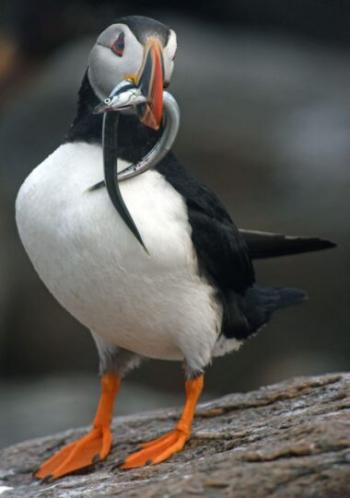
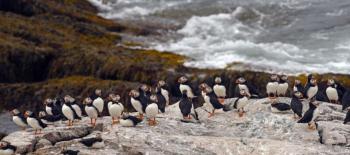
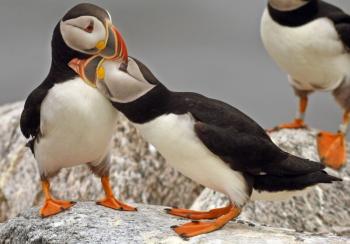
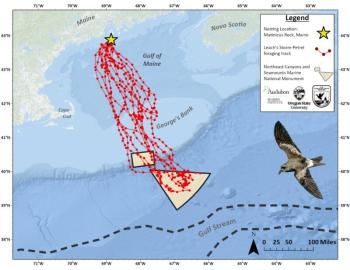





























.png)
.png)
